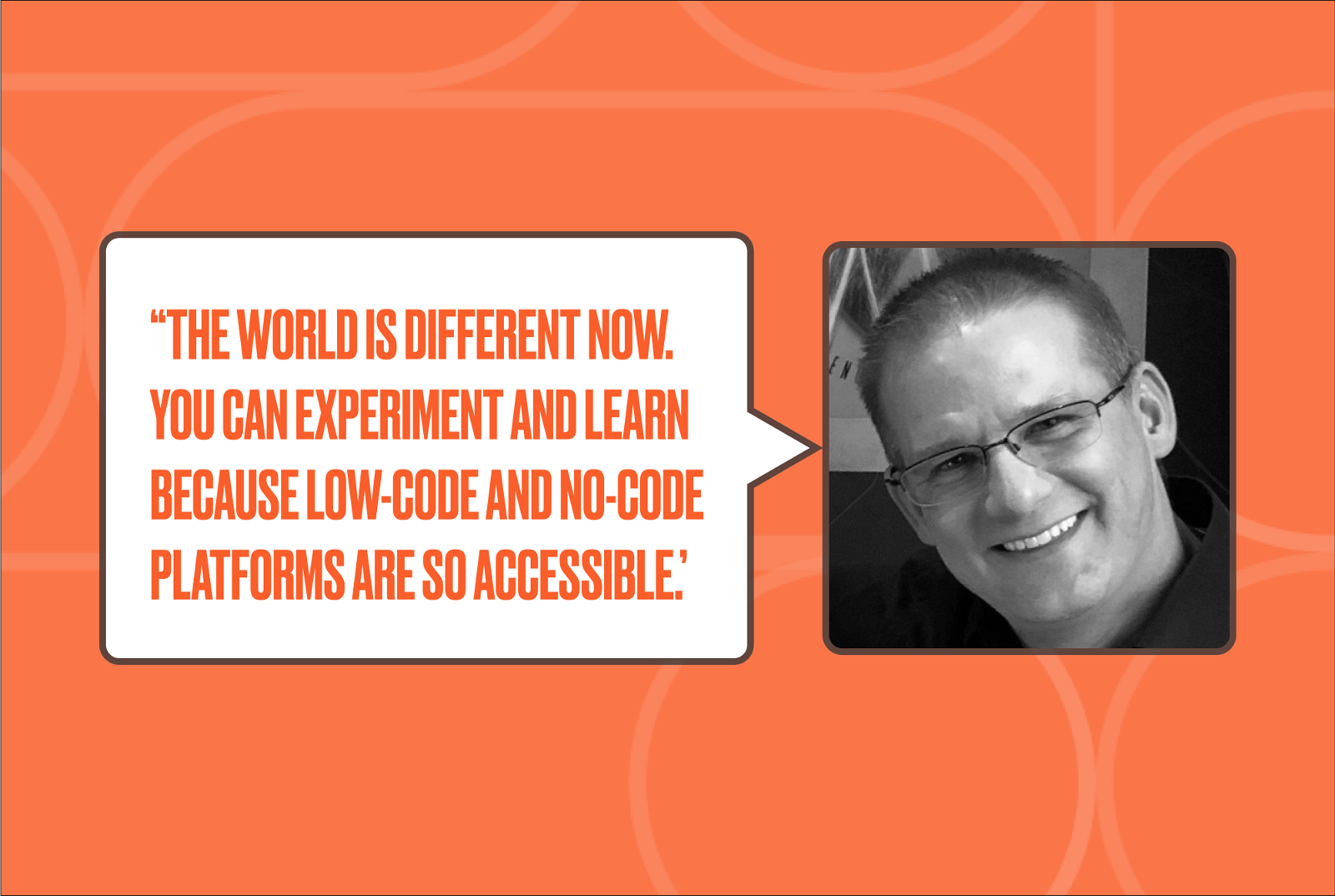The citizen developer's playbook: A decade of insight
An OG citizen developer, Matt Hubbard, gives us the unfiltered and unadulterated truth of his no-code journey.
Table of Contents
Matt Hubbard is what we’d call an authority when it comes to citizen development. Director of Customer Operational Excellence and Success at low-code platform Agile Point – and a significant influence on PMI’s Citizen Developer framework and training resources – it’s something he’s pursued with a real passion for over a decade.
‘When I first dreamt of low-code/no-code (LCNC), before it really existed, I was a project manager at a large automotive company,’ he says. ‘I was responsible for standardising and controlling the business processes for new model development in North America. I couldn’t get an app built. IT told me it would cost several million dollars and take years to build. That’s when I imagined there must be a more flexible way.’
Since then he’s built numerous apps and helped implement no-code/low-code in several large organisations. When it comes to citizen development, it's something of an understatement to say that he knows his stuff. Here he shares some lessons from his journey – along with some practical tips for those starting out.
1. Start with something small
‘I moved onto a new company and soon realised they had similar challenges with building custom software for back office operations: too expensive, time-consuming and inflexible. That’s when I tried my hand at building my first app as a citizen developer. I signed up for a free trial on a LCNC platform and started just poking around to see if it was legit. It was. I essentially made an app to chase down status updates, a pretty common use case for a project manager. It was super simple: a one table app with pre-built views, dashboards, and automated reminders. It only took me 8 hours, but it saved me 200 hours a year.’
Matt’s tip:
- ‘Build a simple use-case and learn from it. Try another one. Your first apps that you build should not be enterprise, mission-critical apps because you’ll have so much invested that you won’t treat it as a trial. So start small, experiment.’
2. Involve IT as early as possible
‘After initial success with a trial account, we purchased a few licences and built more apps. Every time we built something and used it, it proved its value. IT heard about our work and asked us to pause so they could perform a risk assessment. This was a little scary but fortunately we passed the scrutiny, and were permitted to proceed with moderate IT oversight. This experience taught me that partnership with IT is imperative for citizen development to exist as a viable and healthy option. In hindsight, we should have talked to IT from the beginning.’
Matt’s tips:
- ‘The expectation now is that IT builds stuff for you, but the reality is they can’t build everything so they have this huge backlog. What’s the solution to that problem? Citizen development is one really good solution. You want IT to own it. You want IT to be a part of it.’
- ‘LCNC has to be framed as a benefit for both IT and the business, and more of an experiment. Saying: “I’m not asking you to make a huge decision for the company right now, but I think there’s something here, can we investigate it together in a controlled way?”

3. Seek to understand any objections
‘IT pushback came in two forms. Either: “you didn’t get that approved by us” or “what if it has security vulnerabilities?” I was emotional and frustrated because I felt like I had no other options. It was either spreadsheets or this long-term ineffective solution [building with IT]. Both sucked. But I agreed to pause new development while IT properly investigated the platforms. That led to a much healthier relationship for future development. Resisting the objections would likely have strained relationships – and resulted in a lower likelihood of future success.’
Matt’s tips:
- ‘If you do get pushback, seek first to understand then to be understood. Listen to their objections. Appreciate where they’re coming from. Work with them to accommodate those objections. Be patient. Explore ways that CD can help not only you but IT too (like with their project backlog).’
- ‘What I find with big enterprises is that they think the next step is to find the perfect platform. That gets into analysis paralysis, putting a lot on the line to make the right decision right away. That’s the wrong approach. It’s better to have an idea of the kind of platform you’re looking for, a general direction, and then try them. You’ll get to a point where you’re comfortable with a platform, and then you go full-scale with it. And then you start to develop your operating model – standards, guardrails and organisational structures around CD. Aka PMI’s five stage maturity model.’
For more on this, check our article on how to mitigate IT concerns.
4. Scaling LCNC requires different skills
‘On my first few app builds, I didn’t think about app standards for a consistent user experience; I didn’t think about building for easy maintenance; I didn’t think about the efficiency of my formulas and views. You normally start out building apps for yourself, to solve your own problems. But then you realise you can build apps that span a larger audience, outside your department.’
Matt’s tips:
- ‘You have to realise building for lots of people is different. Scaling is a different game. It’s hard. You have to think logically, and start thinking about standards and consistency.’
- ‘It’s about creating an outline: where do you put the save button? What colour schemes will you use? How will you design your workflow? You don’t need to learn all those things before you get started, because then you’ll never start, but once you start to reach a broader audience you need to start learning these skills.’

5. Enterprise environments have four major problems
- Vendor lock. ‘If you use a platform to build so many apps that you’re eventually running your operations off it, then your platform provider can have leverage. It’s probably not wise to have all your eggs in one basket. If you’re a big organisation and you have a couple of platforms to run your apps from, it's helpful because then you have a bit of leverage.’
- Licensing costs, particularly for casual users. ‘There are different pricing models but most of them are user-based models. You can get charged irrespective of how much a user uses the platform, so this gets really tricky if you’re trying to build a public-facing app. Matching your commercial structure and pricing to the way platforms are used is hard. But there are platforms out there with pricing models for unlimited users and even concurrent users (where, say, 100 users can use the platform at one time).’
- A lack of management tools for enterprise scale. ‘Many no-code platforms don’t have development environments: it’s all in production. That’s a challenge when you go to enterprise scale. It means every change you make affects people, live. That’s fine with simple apps but if you have dependencies then how do you make those changes without adversely affecting people in real time? Some platforms also don’t give you easy visibility to all the apps in your ecosystem and info on who’s owning or maintaining them, from a central location. That’s a challenging case too.’
- The UI has certain limitations. ‘The reason no-code is fast is that you’re reusing things that already exist. For something to already exist, it has to have been created. If you’re trying to build in no-code and want to customise the UI, saying “I wish I could have this colour here, or a button here, or make it a little different,” you can’t. It’s the same every time. You don’t have to think about all these extra details; the platform has already thought of that for you. If that’s important to you, you might have to opt for low-code platforms instead. It’s a trade-off today, but maybe not in the future.’
6. If your environment isn’t conducive, look elsewhere
‘If LCNC and citizen development are not allowed because that’s just not how your organisation does things, then you might have to stop beating your head against the wall and move on – I did. Now, when I go in for a process improvement type job, I ask whether they use LCNC. Will they empower me to make apps? And if the answer is no, well, I'm probably going to look elsewhere.’
One final thing to remember
‘Don’t feel like you have to have everything figured out before you take a step. The world is different now - you can experiment and learn because the LCNC platforms are so accessible, unlike the behemoth software purchases of the past.’


Similar Tutorials
Want to read
more articles
like these?
Become a NoCode Member and get access to our community, discounts and - of course - our latest articles delivered straight to your inbox twice a month!












